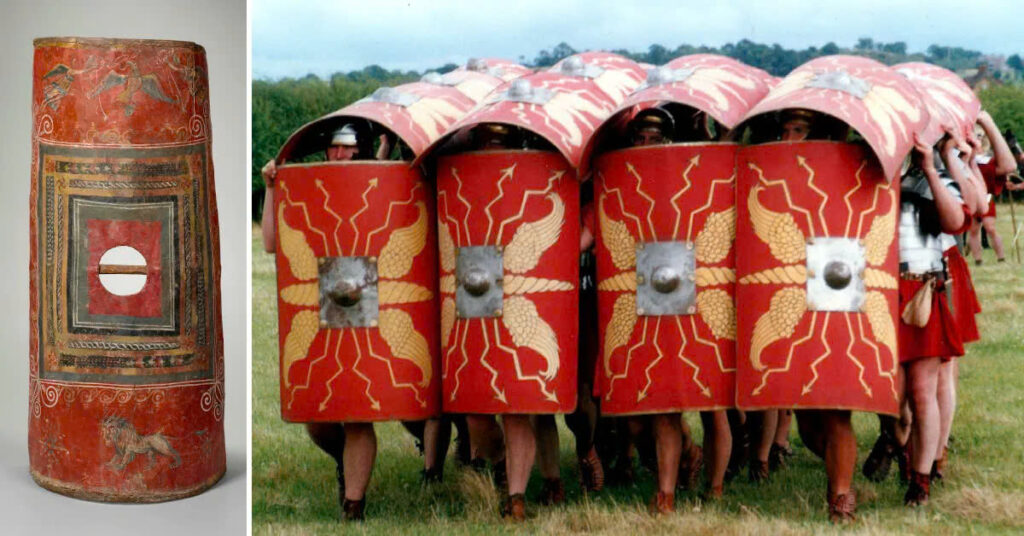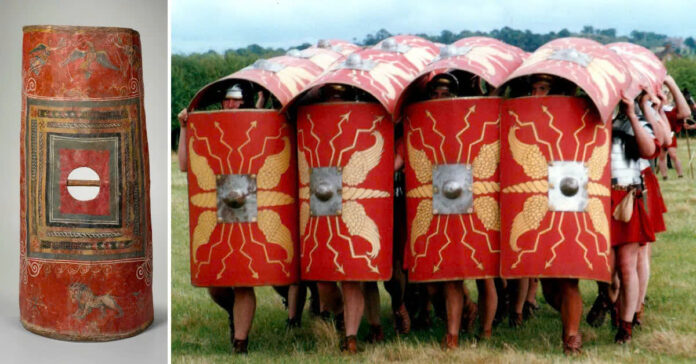Unearthing a Historical Marvel

In the rich tapestry of Roman military history, few discoveries hold as much significance as the intact Roman legionary shield found at the ancient city of Dura-Europos. Discovered in the 1930s, this remarkable artifact is the only complete Roman legionary shield known to exist, dating back to the early 3rd century AD. Its exceptional preservation allows historians, archaeologists, and enthusiasts to gain an unprecedented insight into the daily lives, craftsmanship, and military equipment of Roman soldiers.
The Ancient City of Dura-Europos: A Roman Stronghold
Dura-Europos, situated in modern-day Syria along the Euphrates River, was a vibrant city that changed hands among various empires, including the Seleucids, Parthians, and Romans. By the time it was abandoned in the 3rd century AD, Dura-Europos had evolved into a crucial Roman fortress, safeguarding the eastern borders of the empire against invasions. It was within the city’s ruins that archaeologists uncovered the legendary legionary shield, symbolizing the military prowess of ancient Rome.

This city is a veritable treasure trove of archaeological discoveries, providing layers of understanding about ancient cultures. Its fortifications, temples, and artifacts have enlightened scholars about both Roman and Parthian military strategies, highlighting the cultural exchanges that took place on this distant frontier. Nonetheless, the shield’s discovery stands out as the most valuable find, offering an extraordinary glimpse into the equipment used by Roman legionaries.
The Shield: A Testament to Roman Craftsmanship
This shield is a rare specimen of Roman military gear from the early 3rd century AD. Primarily made of wood and iron, it features a central boss—an elevated section designed to deflect blows in combat. Additionally, the shield is adorned with bronze fittings, showcasing the intricate craftsmanship and functionality characteristic of Roman military design.

The preservation of the shield is remarkable; it survived nearly two millennia, entombed in the soil of Dura-Europos, which provided ideal conditions for its longevity. The anaerobic environment (low oxygen levels) significantly slowed decay, allowing the wooden components to remain intact—making it an unparalleled artifact for studying Roman military history.
The design reflects the standard style used by Roman legionaries during this period, emphasizing the shield’s dual role as both a protective and offensive weapon. The elaborate craftsmanship of the bronze fittings and central boss indicates that this shield was not only practical but also a symbol of the soldier’s status and the military’s strength.
The Roman Legionary: Life Behind the Shield

This shield offers invaluable insights into the life of a Roman legionary in the 3rd century AD. Legionaries were the backbone of the Roman military, professional soldiers who often served long tours in remote and dangerous territories. Their equipment, including the shield, was engineered for defense and versatility, enabling them to combat effectively in various terrains and conditions.
A legionary’s shield was more than armor; it was a vital survival tool. In battle, shields defended against arrows, swords, and spears. Soldiers were trained to use their shields collaboratively, forming the famous Roman testudo (tortoise) formation, where shields interlocked to create an almost impenetrable barrier. The intact shield from Dura-Europos would have been crucial in such formations.
This artifact also reflects the organizational strength of the Roman military. Soldiers were equipped with standardized gear, mass-produced to ensure every legionary had the necessary tools for battle. This uniformity contributed significantly to the Roman army’s effectiveness and its ability to conquer vast territories.
The Importance of the Dura-Europos Shield in Historical Studies
The discovery of this intact shield is extraordinary for historians and archaeologists. While numerous references to Roman shields exist in historical texts and artistic depictions, none match the completeness of the Dura-Europos shield. Its intact state allows researchers to delve into the materials and methods employed in its construction, enriching our understanding of Roman military engineering.

Moreover, the shield serves as a tangible link to the experiences of Roman legionaries. It is a physical reminder of the perils they faced, the battles fought, and the sophisticated military apparatus they belonged to. Through this artifact, historians can better grasp the military strategies of the Roman Empire and the technological innovations that helped sustain its dominance for centuries.
The End of Dura-Europos and the Fate of the Shield

Dura-Europos fell to the Sassanian Persians in the mid-3rd century AD, an event that likely led to the city’s abandonment. The shield was buried amidst the ruins, forgotten for centuries until its rediscovery in the 20th century. The conditions of its burial—possibly within a collapsed structure—contributed to its exceptional preservation.
The Sassanian assault, which resulted in the city’s fall, was part of a larger conflict between the Roman and Persian empires. The intact shield not only represents the military history of Rome but also encapsulates the geopolitical struggles that shaped the ancient world.
Conclusion: A Window into the Roman Past
The intact Roman legionary shield discovered at Dura-Europos is a rare and invaluable artifact that illuminates the lives of Roman soldiers, the craftsmanship of their equipment, and the military history of the Roman Empire. Its preservation provides an exceptional opportunity for researchers to explore the complexities of Roman military technology and the conditions of life on the empire’s frontier.

As one of the few surviving examples of a complete Roman shield, this discovery highlights the significance of archaeology in reconstructing our ancient past. It stands as a symbol of Rome’s military might, its far-reaching influence, and the intricate history of a city situated at the crossroads of empires. Today, it remains a testament to the resilience of the Roman legionaries who once wielded it and the enduring legacy of history itself.

